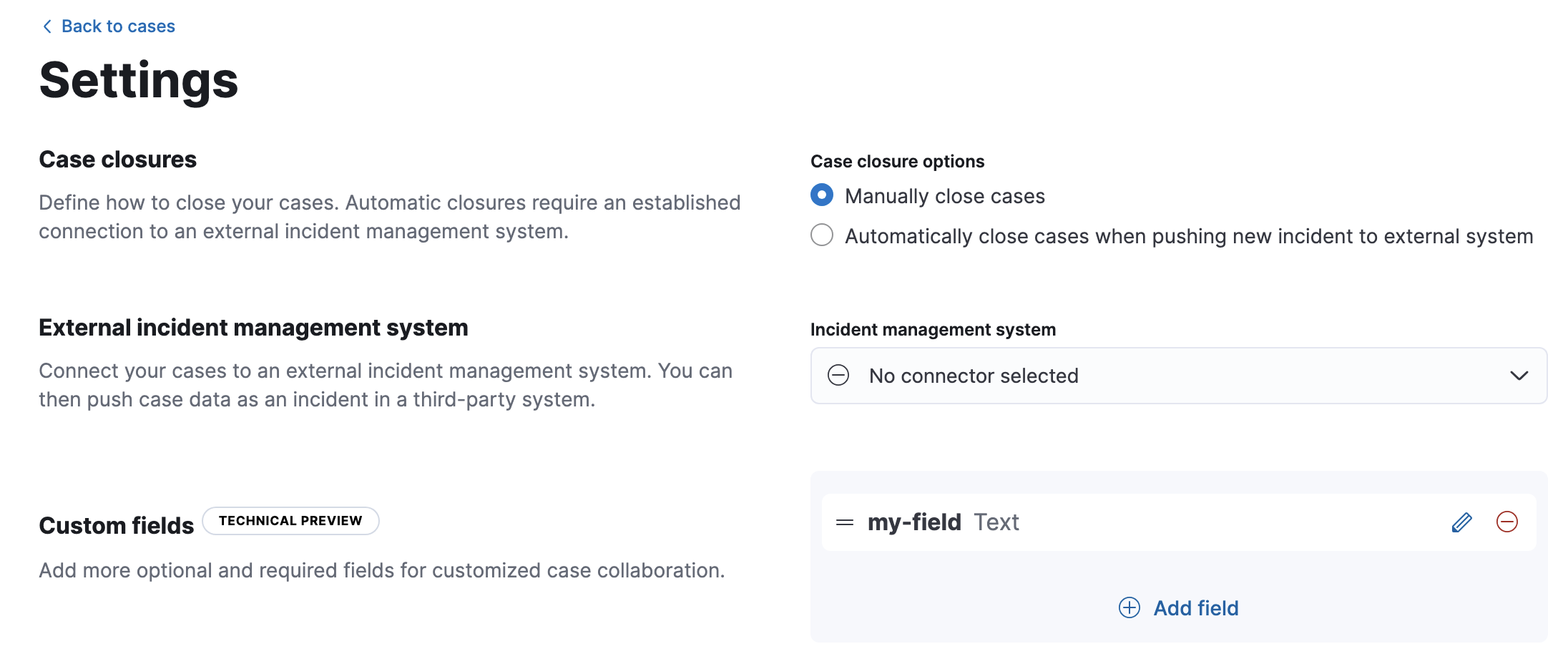Open and manage new cases
editOpen and manage new cases
editOpen a new case
editOpen a new case to keep track of issues and share the details with colleagues.
- Go to Cases → Create new case.
-
Give the case a name, severity, and description.
In the
Descriptionarea, you can use Markdown syntax to create formatted text. - Optionally, add a category, assignees, and tags. You can add users only if they meet the necessary prerequisites.
-
Under External incident management system, select a connector. If
you’ve previously added one, that connector displays as the default selection. Otherwise, the
default setting is
No connector selected. - After you’ve completed all of the required fields, click Create case.
Add custom fields
editThis functionality is in technical preview and may be changed or removed in a future release. Elastic will work to fix any issues, but features in technical preview are not subject to the support SLA of official GA features.
You can add optional and required fields for customized case collaboration.
-
Go to Cases → Settings.

To view and change case settings, you must have the appropriate Kibana feature privileges. Refer to Configure access to cases.
-
In the Custom fields section, click Add field.

This is an autogenerated screenshot. Do not edit it directly.
- Enter a field label.
- Choose a field type: text or toggle.
- If you want the text field to be mandatory in all cases, select Make this field required.
- Click Save field.
You can subsequently remove or edit custom fields on the Settings page.
After you create custom fields, they’re added to all new and existing cases.
Existing cases have null values for the new text fields until you set them in each case.
Add email notifications
editYou can configure email notifications that occur when users are assigned to cases.
For hosted Kibana on Elasticsearch Service:
-
Add the email domains to the notifications domain allowlist.
You do not need to take any more steps to configure an email connector or update Kibana user settings, since the preconfigured Elastic-Cloud-SMTP connector is used by default.
For self-managed Kibana:
-
Create a preconfigured email connector.
At this time, email notifications support only preconfigured email connectors, which are defined in the
kibana.ymlfile. -
Set the
notifications.connectors.default.emailKibana setting to the name of your email connector. - If you want the email notifications to contain links back to the case, you must configure the server.publicBaseUrl setting.
When you subsequently add assignees to cases, they receive an email.
Add files
editAfter you create a case, you can upload and manage files on the Files tab:

The acceptable file types and sizes are affected by your Kibana case settings.
When you upload a file, a comment is added to the case activity log. To view an image, click its name in the activity or file list.
Uploaded files are also accessible in Stack Management > Files. When you export cases as saved objects, the case files are not exported.
Manage existing cases
editYou can search existing cases and filter them by attributes such as assignees, categories, severity, status, and tags. You can also select multiple cases and use bulk actions to delete cases or change their attributes.
To view a case, click on its name. You can then:
- Add a new comment.
- Edit existing comments and the description.
- Add or remove assignees.
- Add a connector (if you did not select one while creating the case).
- Send updates to external systems (if external connections are configured).
- Edit the category and tags.
- Change the status.
- Change the severity.
- Remove an alert.
- Refresh the case to retrieve the latest updates.
- Close the case.
- Reopen a closed case.